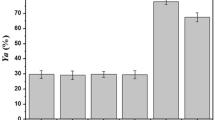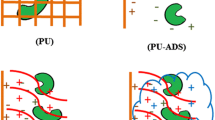Abstract
In this work, the stabilizing effect of bovine serum albumin (BSA), peptone (PEP), and polyethylene glycol (PEG) during immobilization of Candida antarctica lipase on activated carbon was investigated. The influence of enzyme concentration and type of additive, added during the immobilization procedure, was studied using a 22 factorial central composite design. The goal was to maximize the synthetic activity of butyl butyrate, using butyric acid and butanol as substrate in n-heptane. An increase of 31–58% in the esterification activity was obtained when enzyme concentration on the supernatant was enhanced from 86.50 U m L−1 to 226.80 U mL−1. An enhancement in esterification activity of 38–68.95% was observed, depending on the initial enzyme concentration, when PEP was used instead of BSA. No significant increase in the esterification activity was observed when PEP was replaced by PEG. However, thermal stability tests at 50 °C showed that PEG had a higher stabilizing effect.




Similar content being viewed by others

References
Adriano WS, Veredas V, Santana CC, Gonçalves LRB (2005) Adsorption of amoxicillin on chitosan beads: kinetics, equilibrium and validation of finite bath models. Biochem Eng J 27:132–137
Arroyo M, Montero JMS, Sinisterra JV (1999) Thermal stabilization of immobilized lipase B from Candida antarctica on different supports: effect of water activity on enzymatic activity in organic media. Enzyme Microb Technol 24:3–12
Barros Neto BN, Scarminio IP, Bruns RE (2001) Planejamento e otimização de experimentos. 404 pp, ISBN 8526806661
Bastida A, Sabuquillo P, Armisen P, Lafuente RF, Huguet J, Guisan JM (1998) A single step purification, immobilization, and hyperactivation of lipases via interfacial adsorption on strongly hydrophobic supports. Biotechnol Bioeng 58:486–493
Blanco RM, Terreros P, Pérez MF, Otero C, González G (2004) Functionalization of mesoporous silica for lipase immobilization characterization of the support and the catalysts. J Mol Catal B: Enzym 30:83–93
Bornscheuer UT, Bessler C, Srinivas R, Krishna SH (2002) Optimizing lipases and related enzymes for efficient application. Trends Biotechnol 20:433–437
Bosley JA (1991) Supported enzymes. Patent application EQP 424130 A1
Fernandez-Lorente G, Fernandez-Lafuente R, Palomo JM, Mateo C, Bastida A, Coca J, Haramboure T, Hernandez-Justiz O, Terreni M, Guisán JM (2001) Biocatalyst engineering exerts a dramatic effect on selectivity of hydrolysis catalyzed by immobilized lipases in aqueous medium. J Mol Catal B: Enzym 11:649–656
Garrido-Lopez A, Tena MT (2005) Experimental design approach for the optimisation of pressurised fluid extraction of additives from polyethylene films. J Chromatogr A 1099:75–83
Gitlesen T, Bauer M, Adlercreutz PA (1997) Adsorption of lipase on polypropylene powder. Biochim Biophys Acta 1345:188–196
Hung TC, Giridhar R, Chiou SH, Wu WT (2003) Binary immobilization of Candida rugosa lipase on chitosan. J Mol Catal B: Enzym 26:69–78
Kiran KR, Krishna SH, Babu CVS, Karant NG, Divakar S (2000) An esterification method for determination of lipase activity. Biotechnol Lett 22:1511–1514
Martinelle M, Holmquist M, Hult K (1995) On the interfacial activation of Candida antarctica lipase-A and lipase-B as compared with Humicola lanuginosa lipase. Biochim Biophys Acta 1258:272–276
Montgomery DC, Runger GC (2003) Applied statistics and probability for engineers. John Wiley & Sons Inc., 720 pp, ISBN 978-0-471-20454-1
Palomo JM, Munõz G, Lorente GF, Mateo C, Lafuente RF, Guisán JM, (2002) Interfacial adsorption of lipases on very hydriphobic support (octadecyl-sepabeads): immobilization, hyperactivation and stabilization of the open form of lipases. J Mol Catal B: Enzym 19:279–286
Reetz M, Zonta A, Simpelkamp J (1996) Efficient immobilization of lipases by entrapment in hydrophobic sol-gel materials. Biotechnol Bioeng 49:527–534
Rocha JMS, Gil MH, Garcia FAP (1998) Effects of additives on the activity of a covalently immobilised lipase in organic media. J Biotechnol 66:61–67
Rodrigues DS, Cavalcante GP, Ferreira ALO, Goncalves LRB (2008) Immobilization of Candida antarctica lipase type B by adsorption on activated carbon. Chem Biochem Eng Q (in press)
Soares CMF, Santana MHA, Zanin GM, Castro HF (2003a) Covalent coupling method for lipase immobilization on controlled pore silica in the presence of nonenzymatic proteins. Biotechnol Progr 19:803–807
Soares CMF, Santana MHA, Zanin GM, Castro HF (2003b) Efeito do polietilenoglicol e da albumina na imobilização de lipase microbiana e na catálise em meio orgânico. Química Nova 26:832–838
Soares CMF, Castro HF, Santana MHA, Zanin GM (2002) Intensification of lipase performance for long-term operation by immobilization on controlled pore silica in presence of polyethylene glycol. Appl Biochem Biotechnol 98:863–874
Soares CMF, Castro HF, Santana MHA, Zanin GM (2001) Selection of stabilizing additive for lipase immobilization on controlled pore silica by factorial design. Appl Biochem Biotechnol 91:703–718
Squire PG, Moser P, O’Konski CT (1968) The hydrodynamic properties of bovine serum albumin monomer and dimer. Biochemistry 7:4261–4272
Stark MB, Holmberg K (1989) Covalent immobilization of lipase in organic solvents. Biotechnol Bioeng 34:942–950
Triantaflyllou AO, Wehtje E, Adlercreutz P, Mattiasson B (1995) Effects of sorbitol addition on the action of free and immobilized hydrolytic enzymes in organic media. Biotechnol Bioeng 45:406–414
Uppenberg J, Hansen MT, Patkar S, Jones TA (1994) The sequence, crystal-structure determination and refinement of 2 crystal forms of lipase-B from Candida-antarctica. Structure 2:293–308
Wehtje E, Adlercreutz P, Mattiasson B (1993) Improved activity retention of enzymes deposited on solid supports. Biotechnol Bioeng 41:171–178
Xu HX, Li MQ, He BL (1995) Immobilization of Candida-cylindracea lipase on methyl acrylate-divinyl benzene copolymer and its derivatives. Enzyme Microb Technol 17:194–199
Acknowledgments
The authors would like to thank the Brazilian research-funding agencies Finep, CNPq and CAPES (Federal) and FUNCAP (State of Ceará).
Author information
Authors and Affiliations
Corresponding author
Rights and permissions
About this article
Cite this article
Rodrigues, D.S., Cavalcante, G.P., Silva, G.F. et al. Effect of additives on the esterification activity of immobilized Candida antarctica lipase. World J Microbiol Biotechnol 24, 833–839 (2008). https://doi.org/10.1007/s11274-007-9548-7
Received:
Accepted:
Published:
Issue Date:
DOI: https://doi.org/10.1007/s11274-007-9548-7



